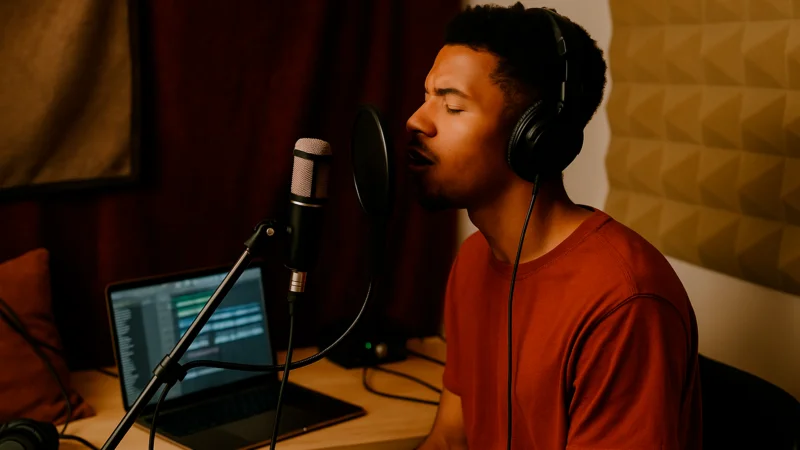
5 Ways to Monetize Your Music (Without Going Viral)
Monetize your music without going viral, learn 5 practical strategies to turn one single into multiple income streams.
You don’t need an expensive mic or a perfect studio to get great-sounding vocals. With the right vocal recording tips, even a budget setup in your bedroom can produce clean, professional-quality recordings. The secret isn’t the gear it’s how you use it.
In this guide, we’ll break down essential vocal recording tips that help you level up your sound, avoid common mistakes, and bring out the best in your voice no matter what mic you’re using.

One of the most overlooked vocal recording tips is mic placement. Even small changes in distance or angle can make your vocals sound muddy, too bright, or full of room reflections.
Pro tip: Record a few test takes at different distances to compare the results.
You don’t need to buy a fancy pop filter to control plosives (those “P” and “B” sounds that cause distortion). One of the most practical vocal recording tips is building your own with:
Pop filters help keep the air pressure from your mouth from hitting the mic capsule directly which reduces harshness and keeps the sound smooth.
Room reflections can ruin a take, no matter how good your performance. That’s why so many vocal recording tips focus on acoustic treatment.
Here’s how to do it without spending anything:
Avoid recording near reflective surfaces like glass or bare walls. The more absorption, the cleaner your take.
No list of vocal recording tips would be complete without talking about gain. If your input level is too high, your vocals will distort. If it’s too low, you’ll introduce noise when boosting it later.
Aim for your loudest peaks to hit between -12 dB and -6 dB on your input meter. This gives you enough headroom while keeping your take clean and full.
Even budget mics can sound good if you manage your noise floor. Here are a few essential vocal recording tips for reducing unwanted sounds:
A clean take = less fixing in post.
A few free tools can go a long way in polishing your vocal takes. Some highly recommended ones for vocal recording tips include:
At the end of the day, vocal recording tips are about mindset and technique. No matter what mic you own, if you follow the steps in this guide positioning, pop filter, acoustic treatment, gain control, and noise management you’re already ahead of most beginners.
Practice. Test. Listen. Improve. These steps will do more for your vocals than any expensive gear.
I work with independent artists to improve their sound, organize sessions, and get clean, emotional vocal takes even from a home studio.
Click here to work with me and let’s bring your voice to life.

Monetize your music without going viral, learn 5 practical strategies to turn one single into multiple income streams.

Discover essential vocal recording tips to improve your home studio and capture clean vocals with the mic you already have.

Discover why music artist branding is essential before releasing your first tracks, build recognition and attract loyal fans.

Learn how to release a single with purpose and strategy. Discover how independent artists can turn one song into multiple income streams.